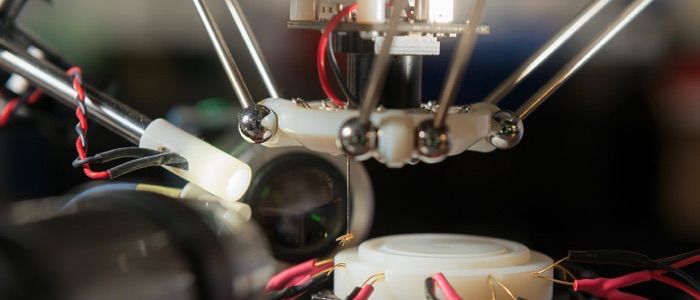 A fruit fly hangs unharmed at the end of the robot's suction tube. The robot uses machine vision to inspect and analyze the captured fly. (Photo: L.A. Cicero/Stanford News)
A fruit fly hangs unharmed at the end of the robot's suction tube. The robot uses machine vision to inspect and analyze the captured fly. (Photo: L.A. Cicero/Stanford News)
- Written by Stanford News
Dexterous robotic manipulation of alert adult Drosophila for high-content experimentation
FeaturedA new lab robot is an example of how clever robotics might speed research and open new fields of study. Stanford News reports on a team of bioengineering scientists that have created a robot with excellent "hand-eye coordination" that can visually inspect active flies and carry out behavioral experiments.
Their paper in Nature Methods describes how a team led by Stanford associate professor of biology and of applied physics Mark Schnitzer has developed a robot that enables high-content studies of alert adult Drosophila fruit files by combining operations including gentle picking; translations and rotations; characterizations of fly phenotypes and behaviors; microdissection; or release.
"Robotic technology offers a new prospect for automated experiments and enables fly researchers to do several things they couldn't do previously," Schnitzer said. "For example, it can do studies with large numbers of flies inspected in very precise ways." The group did one study of 1,000 flies in 10 hours, a task that would have taken much longer for even a highly skilled human.
Read the full article at Stanford News.
Visible Legacy Comment
This project was funded by the the W.M. Keck Foundation, NIH Director's Pioneer Award, and others. Robot automation guided by visual patterns enables a range of new experiments with fruit files, and the clever ideas may be applied by industry for example clinical trials. The Schnitzer group is one doorway into Stanford Bio-X which aims to catalyze discovery and bring forward interdisciplinary solutions in benefit of human health by crossing the boundaries between biology, engineering and medicine. See the latest research from the ecosystem by exploring the map below!
updated 161003.1
Additional Info
-
Navigator:
 Explore the map in Navigator
Explore the map in Navigator - Widget:
- Caption: Dr. Schnitzer has longstanding interests in neural circuit dynamics and optical imaging, and his laboratory has three major research efforts: In vivo fluorescence imaging and behavioral studies of cerebellar-dependent motor control and motor learning; Development and application of fiber-optic fluorescence microendoscopy imaging techniques for studies of learning and memory in behaving mice and for clinical uses in humans; Development of high-throughput, massively parallel imaging techniques for studying brain function in large numbers of Drosophila concurrently.
Related items
- Multi-Tasking Wearable Continuously Monitors Glucose, Alcohol, and Lactate
- Privacy-preserving camera captures only the objects you want
- USF CUTR receives $3.5M contract from the U.S. Department of Energy
- WSU Researchers develop recyclable composites
- JHU Med Scientists Create Nanobody That Can Punch Through Tough Brain Cells
